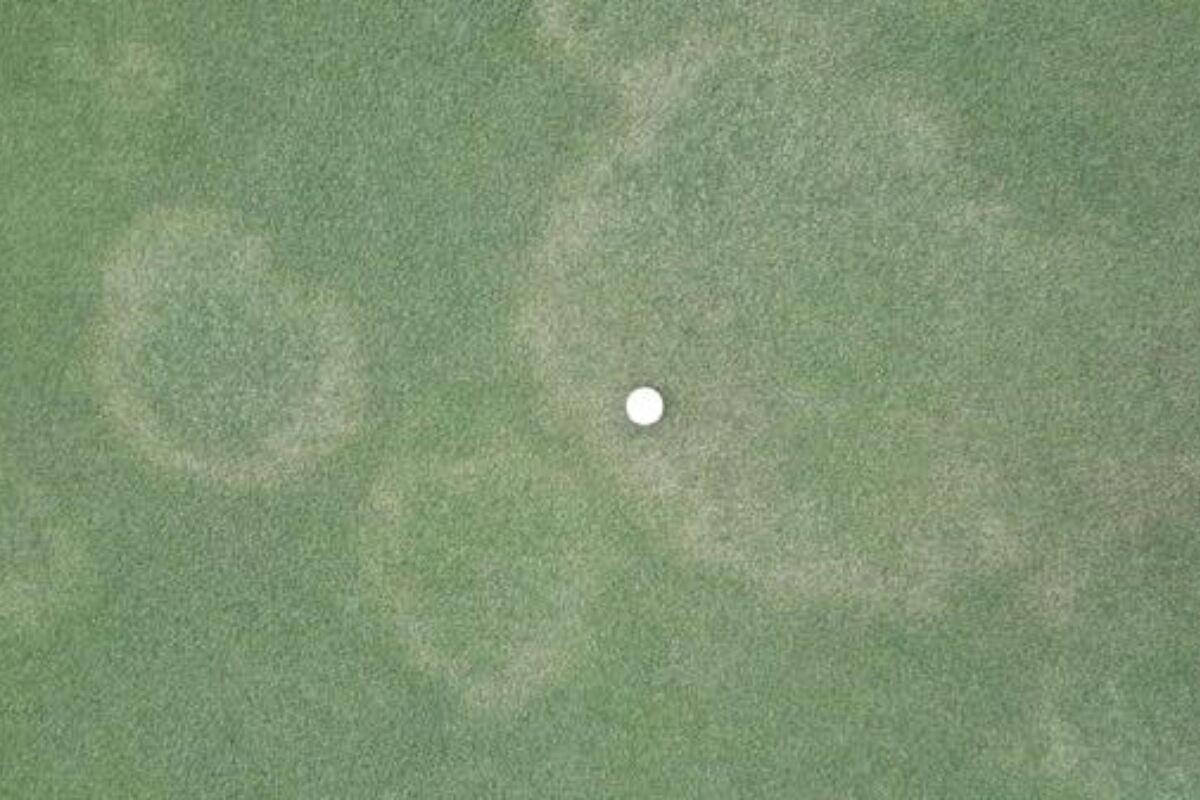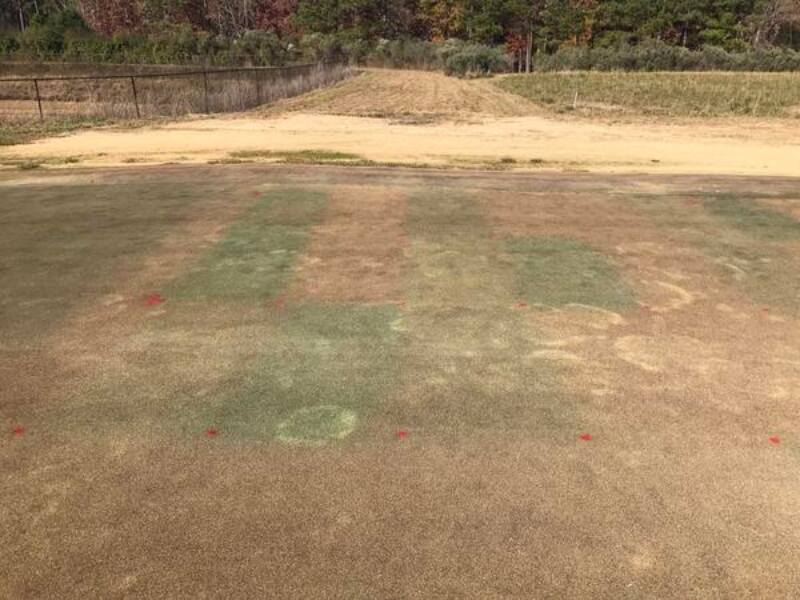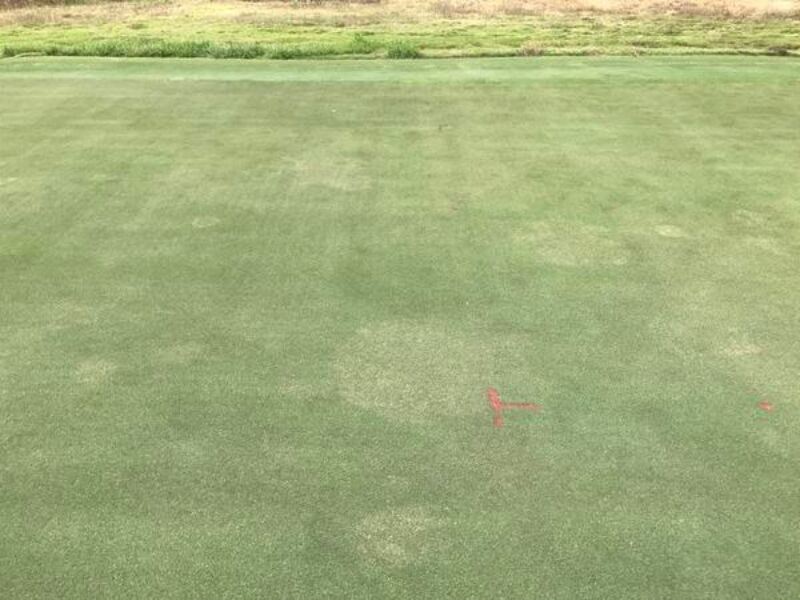
The nightmare of having take-all root rot (TARR) on your grass starts with lime-green tinting that evolves into brown turf and heart-breaking bare patches. Caused by a nasty fungus that rots the roots, TARR often kills the grass, requiring reseeding.
You need diligent lawn care practices and fungicide applications to save your lawn, and quickly recognizing the infection is essential. Read this article to learn how to read the signs and symptoms of TARR, a quick test to take at home, plus the best solutions for treating the turf, repairing the damage, and ensuring the villain doesn’t return.
How to Recognize Take-All Root Rot Disease
Identifying TARR as fast as possible is essential for lawn recovery. In this section, we tell you all about how to recognize this fungal disease, including:
- Signs and Symptoms of Take-All Root Rot
- How to Test for Take-All Root Rot
- When is TARR Active in Turfgrass?
- Similar Diseases and Pest Damage You Can Confuse With TARR
Signs and Symptoms of Take-All Root Rot

TARR infection and damage happen beneath the soil, at the root level. If the grass is healthy and exposed to no or low stress, foliar symptoms of the TARR disease might never appear. Otherwise, turf begins to suffer visibly. Here are the signs you might see:
- Lime-green and yellow patches: Damaged grass starts by forming light-green to yellow patches of irregular shapes where the grass is thinning. By now, the fungi have been active for a few weeks, and roots are partially damaged, making nutrient and water absorption difficult.
- Brown patches and bare ground: As the disease progresses and the root system is completely compromised, affected grass turns brown and dies. Brown and bare patches start forming in your lawn.
- Short, dark-colored roots: Grass infected by the TARR fungus starts with thin, off-white roots with isolated black lesions. They grow shorter than the roots of healthy plants, less dense, somewhat brittle, and later turn dark brown to shiny black. Dark rot is also present on rhizomes, stolons, and nodes.
- Easy to pull off stolons: Since roots can longer keep them in the ground, damaged stolons are easy to remove from the lawn by hand.
- Microscopic fungal signs: With a good hand lens or microscope, you can observe black strands of fungal mycelium on the surface of stolons and leaf sheaths.
How to Test for Take-All Root Rot
Go to a damaged area in your lawn and pull on some grass plants. If they pull off easily, it’s probably TARR. Take a closer look at their roots, stolons, and rhizomes. With a take-all root rot infection, they should be shorter, less dense than usual, with a dark brown to black color and a smell of rot.
To be 100% sure, take some grass samples from your lawn. Choose plants inside the damaged area, at its edge, and outside the patch. Dig the soil to collect entire grass plants with roots, stolons, stems, and blades. Send them to a plant pathology lab in your area for testing.
When is TARR Active in Turfgrass?
According to North Carolina University, the optimum soil temperatures for the fungus causing TARR to develop are between 77 and 86°F. That fungus is known as Gaeumannomyces graminis var. graminis (Ggg for short).
Initially, TARR was considered more of a late spring and summer disease. Recent studies show that it can manifest year-round in some turf types, like ultra dwarf Bermudagrass varieties.
Cooler temperatures, cloudy weather, and rain are all environmental conditions that can trigger Ggg in vulnerable turf.
The Ggg fungus lives on the roots and stolons of grass and becomes active during spring and fall when temperatures are suitable. Typically, symptoms are visible from May to September, but the period depends on where you live and how temperatures and moisture levels affect your lawn.
Similar Diseases and Pest Damage You Can Confuse With TARR
Take-all root rot is not the only menace in warm-season grasses. A few other common lawn diseases and pests can damage the turf in similar ways that can be easily mistaken for TARR, such as:
Brown Patch
Both diseases cause circular brown patches in the turf in summer and fall. But, brown patch causes brown and copper lesions on leaves, while with TARR, leaves simply wilt, blight, dry out, and die.
Another difference is that brown patch doesn’t damage the roots and crown. Only leaf sheaths are rotten at the base. Pulling out from the top of the blades, they come off quickly, but the rest of the plant remains in the soil. Since TARR damages the roots, entire plants pull off from the ground when pulled.
Dollar Spot
Grass plants affected by dollar spot have tan lesions with reddish-brown margins. The disease also causes small, gold dollar-size patches that grow about 5 inches wide and can merge to form larger patches.
Dollar spot is a foliar disease, so the roots and crown are not damaged, and grass recovers in the center of patches, giving them a frog-eye appearance.
Large Patch
The large patch disease causes small, irregular patches up to 12 inches wide with tan-orange grass. They might grow into larger damaged areas with an orange exterior ring. The disease damages basal leaves and crowns but doesn’t kill stolons and roots. Stolon and root damage may indicate TARR.c
Chinch Bugs
Feeding on the grass in your lawn and leaving toxic substances behind, chinch bugs can cause similar patches of dry, wilted, and dead grass from June to August. To check for their presence, remove the top and bottom from a coffee can, put it on the soil in a damaged area, and press it into the soil 2 to 3 inches deep. Fill it with water. Some chinch bugs will float to the top immediately if any are present.
Lawn Grubs
If you have grubs in your lawn, they’ll chew the grass’s roots, causing thinning, wilted, and dead patches of grass that look similar to drought stress. When you pull at damaged grass, it comes off easily, similar to a TARR infection. The difference is that what’s left of the grass root and crown has no brown rot color or smell.
To test for grubs, peel off about 1 square foot of lawn in a damaged area and sift around in the soil. If you have a grub infestation, you will find a few.
Root Knot Nematodes
These tiny but nasty organisms enter the grassroots and feed on their nutrients, killing the plants. Symptoms are similar to TARR, including yellowing patches of grass that eventually wilt, turn brown, and die. Roots infested with nematodes are shortened and thickened, with observable swellings along the root system.
How to Treat and Prevent TARR
While some fungal diseases can be fought with proper lawn care, treating and preventing the return of take-all root rot takes both cultural practices and chemical control with fungicides.
In this section, learn about:
Cultural Practices to Fight TARR
The best strategy in fighting TARR is to use proper lawn care practices. These help to grow robust, strong grass that can withstand infection and limit favoring factors. In a nutshell, what you’ve got to do is:
Test the Soil Periodically
Balanced soil is the best protection against fungal disease. Test your soil before applying pH correctors, lawn fertilizers, or other soil amendments to ensure you’re adding all the right nutrients and none that will lead to excess.
Keep the Soil pH Slightly Acidic
Use acidifying forms of slow-releasing nitrogen to lower soil pH if necessary. Choose products with equal amounts of nitrogen and potassium that offer magnesium and micronutrients. Avoid nitrate-nitrogen and quick-release nitrogen.
Feed the Leaves During Outbreaks
During a TARR infection, the root system is compromised and can’t feed the plant with the needed nutrients. Apply small amounts of foliar feeding with nitrogen, potassium, phosphorus, and micronutrients to help the grass fight the disease and limit plant death. The micronutrient manganese is commonly provided in a sulfate form and is known to reduce disease severity.
Here are a few popular products used by lawn owners:
- Organic SuperGreen Kelp Foliar Spray for Plants
- Turf Builder Liquid Lawn Fertilizer for All Grass Types
- True Foliar Fertilizer with 50% Nitrogen from Slow Release
Aerate and Dethatch
Core aeration loosens the soil, improving water drainage, allowing roots to develop easier, and increasing access to oxygen, nutrients, and water. Dethatching allows grass plants to grow better, improves drainage and airflow, and removes a potential fungal shelter.
Aerate and dethatch the lawn in May and June when warm-season grasses grow and quickly recover from mechanical damage.
If you’re considering hiring a lawn care service for these maintenance needs, it’s worth knowing that aeration costs about $75 – $225 depending on yard size, while dethatching costs $0.15 to $0.35 per square foot.
Maintain the Correct Mowing Height
Avoid scalping the lawn in the spring. Close mowing keeps grass roots short and reduces the blades’ photosynthesis capacity, slowing growth and limiting resistance to pests and fungi.
Keep the proper mowing height for your grass type and the current season, only cut a maximum of ⅓ of the grass’s height at once, and change your mowing pattern periodically. Read more on how to mow the lawn correctly in this guide.
Avoid Root-Inhibiting Herbicides
Don’t apply root-inhibiting herbicides on your lawn if you have take-all root rot. It can affect root development in turfgrass, making it more challenging to protect against TARR.
Irrigate Early in the Morning
Early morning irrigation allows the water time to seep into the soil before the heat strikes. It promotes deep, robust root growth and protects grass blades from foliar diseases like dollar spot and large patch.
Install an automatic sprinkler system for irrigation at ungodly hours, like 4 to 6 a.m. (which is when experts recommend watering your lawn and garden). It costs about $0.60 per square foot to install a new sprinkler system, but you’ll save money on your water bill and fungicide treatments in the long run.
Topdress with High-Quality Compost
Use compost to improve your soil and give your grass a better chance to fight TARR. Apply it in spring and fall. It adds beneficial microorganisms, organic matter, and essential nutrients.
Mushroom compost has good results in preventing TARR but can increase the soil pH. Consult a lawn treatment pro or your local Extension Office agent before applying mushroom compost.
Sphagnum peat moss is also recommended for TARR treatment. It’s available at local garden centers and online from:
Trim Shade Trees and Shrubs
Excessive shade prevents warm-season grasses from growing healthy and limits airflow and evaporation, keeping soil moisture high. Trim the trees and shrubs around the lawn to improve ventilation and ensure proper sunlight.
Chemical Control of TARR
TARR infection can be managed with fungicides. Curative treatments are less effective than preventive ones, so the best strategy is to apply them outside the outbreak period. Apply in the spring, in sessions 14 days apart, and during the fall, in sessions 28 days apart.
Use fungicides that include active ingredients proven to affect TARR, such as azoxystrobin, myclobutanil, propiconazole, thiophanate-methyl, and triadimefon. Here are three products commonly used to treat TARR:
How to Repair the Lawn After TARR Infection

TARR targets and kills root systems, so affected areas often require a complete makeover. Remove the dead grass along with a thick layer of the topsoil. Apply new topsoil and reseed or install new sod to replace your infected grass.
Centipedegrass is a better alternative to the more popular warm-season grasses Bermuda, Zoysia, and St. Augustine. It has a better resistance to the TARR fungus.
TARR can return if you fail to use proper lawn care practices and apply preventive fungicides in due time.
What Causes TARR in Grass?
The nasty pathogen causing TARR disease is Gaeumannomyces graminis var. graminis, also called Ggg. It is a soilborne fungus that dwells in the ground in warm climates and infects turfgrass and cereals like wheat and barley. It’s a common lawn disease homeowners fight with across the warm-season grass zone (Texas, Florida, Louisiana, Mississippi), but it also makes its presence felt in the transition zone.
Ggg attacks the roots of young plants and spreads from plant to plant through hyphae and hyphopodia – long, branching, hair-like structures forming the Ggg mycelium that attach to and penetrate the grass’s roots. The fungus kills the grass by blocking its conductive tissue and making nutrients and water absorption impossible.
Left untreated, it builds up in the soil and can lead to the total decline of entire lawns. If you suspect a TARR infection, act quickly. Implement a mix of cultural practices and fungicides to save the grass as soon as possible, or hire a lawn treatment pro to do so for you.
Susceptible Turfgrasses
Also called Bermudagrass decline, the take-all root rot disease is an infection of all warm-season grasses. Bermudagrass, St. Augustinegrass, and Zoysiagrass are most commonly affected, but TARR also infects centipedegrass and creeping bentgrass. It’s a disease of young turf, usually attacking lawns under five years old.
Factors Favoring TARR Outbreaks
The take-all root rot fungus thrives in stressed grass exposed to high moisture. Your lawn is at risk when some of the following factors join to create favorable environmental conditions:
- High moisture: Extended periods of rainfall and heavy dew that keep the topsoil soaked for days or weeks can trigger Ggg.
- A soil pH of over 6.5: Turfgrasses need slightly acidic soil to absorb nutrients properly. In alkaline ground, they are more vulnerable to disease. A soil with a naturally high pH is as much a factor as excessive treatments with lime made to correct a too acidic pH.
- Thatch buildup: A thick thatch layer keeps moisture in the soil longer and creates a comfortable environment where fungi can stay dormant during unfriendly weather conditions. It also hinders grass growth by smothering stems and blades.
- Soil compaction with poor drainage: Compacted soil is tight and heavy around the grass’s roots, making growth difficult. It also limits their access to oxygen and nutrients and drains water poorly, allowing puddling and soaked topsoil, excellent conditions for fungal growth.
- Excessive irrigation: You can trigger TARR if you overwater your lawn, your watering doubles up with rainfall, or you’re irrigating in small amounts and often, keeping the topsoil moist permanently. When the soil surface stays moist, fungi thrive, and grass roots grow shallow and more vulnerable to drought and disease.
- Nighttime irrigation schedule: Watering the grass in the evening or at night keeps the foliage and topsoil moist overnight, creating good conditions for the TARR fungus to thrive.
- Shaded areas: Lawns partially shaded are more susceptible to developing TARR during rainy periods since water evaporates slower.
- Spring overfertilization: Applying too much nitrogen fertilizer during spring takes the grass’s focus from developing healthy roots to growing leaves, which makes it more vulnerable to TARR.
- Overuse of herbicides: Used in large amounts or at the wrong time, weed killers can affect turf development. Use herbicides only in areas of your lawn overrun by weeds and only in the amount recommended by the manufacturer. Do not apply herbicides on a lawn already suffering from take-all root rot.
- Improper mowing height: Mowing the turf too close or scalping the lawn decreases the grass’s ability to protect itself from diseases and promotes shorter, shallower roots.
FAQ About Take-All Root Rot
Is Take-All Patch the Same as Take-All Root Rot?
Yes. Take-all root rot is also called the take-all patch disease.
Can You Cure Take-All Root Rot?
Treat take-all root rot with proper fungicides meant for this disease. Make preventive fungicide applications in spring and fall. Spread a good-quality topdressing to feed the grass with balanced nutrients. Mow and irrigate correctly and keep a proper fertilization schedule with slow-release nitrogen.
What Does Root Rot in Grass Look Like?
The root rot disease creates lime-green to yellowish patches that turn brown, leading to patches of bare ground when the grass dies.
What Is the Best Fungicide for Take-All Root?
The best lawn fungicides to treat take-all root rot have the active ingredients azoxystrobin, myclobutanil, propiconazole, thiophanate-methyl, and triadimefon.
When to Call the Professionals
Take-all root rot is a deadly, aggressive lawn disease. Contact a lawn treatment company as soon as you notice the first signs of infection for the best chance of saving your lawn. LawnStarter can connect you with the best lawn treatment pros in your area who have the expertise to diagnose your lawn and access to the best fungicides and other treatments to help it recover.
LawnStarter participates in the Amazon Services LLC Associates Program, an affiliate advertising program. LawnStarter may earn revenue from products promoted in this article.
Main Photo Credit: NC State Cooperative Extension